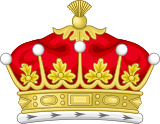Earl of Stirling facts for kids
Quick facts for kids Earldom of StirlingHeld with Earldom of Dovan |
|
|---|---|
 
The coronet and coat of arms of the 1st Earl of Stirling.
|
|
| Creation date | 14 June 1633 |
| Monarch | Charles I of England |
| Peerage | Peerage of Scotland |
| First holder | William Alexander, 1st Earl of Stirling |
| Last holder | Henry Alexander, 5th Earl of Stirling |
| Subsidiary titles | Viscount of Canada Lord Alexander of Tullibody Baronet Alexander of Menstrie |
| Status | Dormant |
| Extinction date | 1739 |
| Seat(s) | Menstrie Castle |
The Earl of Stirling was a special title in the Peerage of Scotland. A "peerage" is a system of titles for nobles, like dukes, marquesses, earls, viscounts, and barons. This title was created on June 14, 1633, for William Alexander. He was already known as the 1st Viscount of Stirling.
Before becoming an Earl, William Alexander had received other important titles. He was made a Baronet of Menstrie in Clackmannanshire on July 12, 1625. A Baronet is a hereditary title, meaning it can be passed down in a family. Later, on September 4, 1630, he became Lord Alexander of Tullibody and Viscount of Stirling. He was also made Viscount of Canada when he became Earl of Stirling. In 1639, he received the title Earl of Dovan. All these titles were part of the Peerage of Scotland. The titles became "dormant" in 1739. This means no one officially held them after the fifth Earl died.
Contents
Who Were the Earls of Stirling?
The title of Earl of Stirling was held by five different people. They were all from the same family.
- William Alexander, 1st Earl of Stirling (1576–1640)
- William Alexander, 2nd Earl of Stirling (died 1640)
- Henry Alexander, 3rd Earl of Stirling (died 1644)
- Henry Alexander, 4th Earl of Stirling (died 1691)
- Henry Alexander, 5th Earl of Stirling (1664–1739)
Later People Who Claimed the Title
After the fifth Earl died, the title became dormant. However, some people later tried to claim they were the rightful Earl of Stirling.
William Alexander's Claim
William Alexander was a military officer from New Jersey. He was a major-general in the Continental Army during the American Revolutionary War. From 1756 to 1759, he tried to claim the dormant Earldom of Stirling.
He believed he was the oldest male descendant of the first Earl's grandfather. However, his claim was rejected by the House of Lords in 1762. The House of Lords is part of the British Parliament. Even though his claim to the earldom was turned down, he was allowed to vote in the election for Scottish representative peers.
Alexander Humphrys-Alexander's Claim
In the 1800s, another attempt was made to claim the title. This time, it was by Alexander Humphrys-Alexander (1783–1859). He tried to say that there was a new grant for the title of Earl of Dovan. He also claimed a new way the title of Earl of Stirling could be passed down.
Mary Hill, Marchioness of Downshire also brought a petition to the House of Lords in 1832. She claimed she was the rightful heir. She was a descendant of Judith Alexander, who was the sister of Henry, the Fifth Earl of Stirling.
A court case in 1839 looked into the documents supporting Humphrys-Alexander's claim. The court found that at least two of the seventeen documents were not real. They were forgeries. Humphrys-Alexander himself was found not responsible for making them.
This interesting case and the forged documents inspired a very popular novel. It was called Ten Thousand a-Year by Samuel Warren. Warren also wrote about the case in his own writings, calling the article "The Romance of Forgery."
See also
- Province of New York: In 1664, the Duke of York bought land from Stirling. This included Long Island and other areas.


